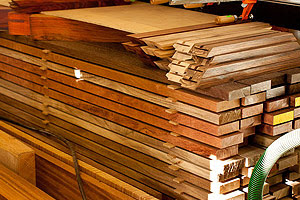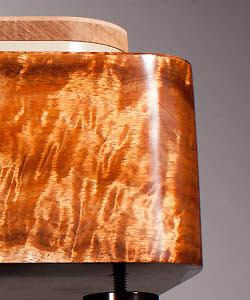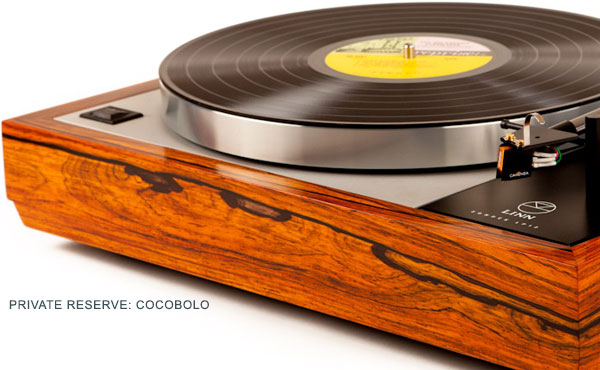It takes a lot of know how to create a lasting, effective and beautiful looking turntable plinths. Here is an in-depth look at the Chris Harban’s Woodsong Audio bespoke creations…
“Wood must rank highly among the most essential things to human life, not too far behind air, water, food and love. Wood gives us heat, shelter, tools, art, and music, among other things. Wood can be found in incredible variety of color, density, strength, tonal quality, and other properties. I have been gifted with an appreciation for the many forms of wood, especially its aesthetic and functional beauty. Wood has proven itself as an excellent material for turntable plinths, speaker cabinets, and furniture…
For the most part, all of the woods I use are ‘Hardwoods’, and come from all over the world. When possible, I try to purchase from certified sustainable sources. The great rainforests are an essential part of the eco-system in which we live, and depend on. In considering them as a resource, we need to use them wisely.”
All wood starts as a tree which has been cut down. It is then rough sawn into smaller boards, and larger ‘cants’ which need to be carefully stored to allow the sap and water moisture to leave the wood. The cants are sawn into boards, and then, often ‘kiln’ dried which quickly removes much of the moisture. Some woods which are very dense can only be partially kiln dried without destroying it. Most wood, as it is sold, still has too much moisture to be used in fine woodworking projects, and needs to be carefully stored until it is dry enough to use. This is done by stacking the wood in layers separated by thin strips of wood to allow airflow.
 Tracking For some very dense woods, like Cocobolo, or Ebony, this can take a long time, even years. If the wood is not completely ‘seasoned’ prior to use, the final product can warp or crack. Many woodworkers, and especially luthiers, consider the best wood to be completely air-dried, which takes a long time. I am constantly looking for beautiful boards with suitable grain for making turntable plinths. When a board enters my shop, it is generally rough sawn, stickered, and racked in a conditioned space. Woods like Ebony or Bocote are rough milled, immediately coated in shellac, and watched for months, or years, until it is ready to use. Currently, I have well over 100 plinth blanks that have been racked for more than a year and a half, and this ‘palette’ is growing all the time. Some boards have been racked for more than 10 years, and will eventually find their project.
Tracking For some very dense woods, like Cocobolo, or Ebony, this can take a long time, even years. If the wood is not completely ‘seasoned’ prior to use, the final product can warp or crack. Many woodworkers, and especially luthiers, consider the best wood to be completely air-dried, which takes a long time. I am constantly looking for beautiful boards with suitable grain for making turntable plinths. When a board enters my shop, it is generally rough sawn, stickered, and racked in a conditioned space. Woods like Ebony or Bocote are rough milled, immediately coated in shellac, and watched for months, or years, until it is ready to use. Currently, I have well over 100 plinth blanks that have been racked for more than a year and a half, and this ‘palette’ is growing all the time. Some boards have been racked for more than 10 years, and will eventually find their project.
Though my LP12 plinths are made from solid, kiln dried and properly seasoned wood, other styles of plinths, like the massive CLD Garrard plinths, call for the use of veneers.
ABOUT VENEERS
veneer Some boards are more suited to being cut into veneers– generally wide, pretty boards, from which the beautiful grain can be spread out over a wide area, in a manner that allows for grain matching.
For many people, myself included for many years, veneer is a word associated with lesser quality woodworking. We have all seen examples of cheap woodworking where the veneer shows bubbles, or is pulling away from the corners and joints, or the corners are sharp and thin. Commercially available veneers are generally 1/42″ thick, or 0.08mm, and which, I consider to be a low quality option in almost all applications. This is by far the most common form of veneer used in woodworking.
I cut my own veneers, and surface, and surface them to between 1mm, and 3mm, depending on the intended usage. Thicker veneers allow for more ‘easing’ on the corners with a softer feel, and are less prone to catastrophic damage. Thicker veneers also allow for deeper sanding into un-torn wood, enabling the surface to be polished prior to finishing and really bring out the beauty in the wood. This might not sound like it is important, but when you see the difference ‘in the flesh’, there is no question of the higher quality result.
Veneer can be utilized to a very high standard, allowing a wider set of ‘rules’ to work with than solid wood allows. For instance, a plinth made from a plank of solid wood would be more likely to warp, than a stack of plywood, or other materials. In addition, layers of specific, different materials, or Constrained Layer Damping, or CLD, has proven to yield a sonically superior plinth, and when veneered, a highly aesthetically pleasing result can be had. Veneer, when properly used, can be very high quality, and allows things which are not possible with solid wood.
It is common to see plinths made by wrapping a plywood stack with solid hardwood, sometimes up to an inch thick. This is a bad idea! Building with solid wood always requires allowing wood to move, to swell and contract with temperature, seasonal humidity change, and the fact that wood will almost always shrink slightly over a long period of time under almost any finish. Over the centuries, woodworkers have come up with many ingenious ways of allowing wood to move in furniture construction, without revealing gaps, methods such as sliding dovetails, floating panels, pivoting pins, and numerous other methods.
A stack of plywood does not move much at all, that is one of the beauties of plywood. Solid wood always moves. If you glue a piece of wood which has minute amounts of movement, to something that does not move, like a stack of plywood, in time it will fail, glue joints will be felt, or open up. A plinth of stacked plywood construction, wrapped with thick, solid wood, mitered at the corners ( or even butt joints), in time, will fail. It will likely look good for a couple of years, if the wood is seasoned well, but within 10 years time, in most cases you will have joints opening up, failed glue joints. This concept is very important to understand, it is almost as certain as gravity. When I build a plinth, I want it to last a very long time, and then be able to be refinished, or repaired. I engineer this into my plinths, even if it is not immediately obvious. Thin veneers, up to maybe 3/16” (3-4mm) are safe with regards to movement. Thicker, solid wood has ‘a mind of their own’ , which must be taken into account with good construction techniques. Not much will stop a board that wants to move. If someone tells you otherwise, get another opinion. Using veneers, from the commercially available type that are 1/42” thick, to shop cut veneers that are up to 3-4mm thick mostly eliminates the issue of wood movement, one of the great things about veneer.
ABOUT FINISHES
 Finishes can be broken down into penetrating finishes, that penetrate into the surface of the wood, and surface building finishes, that bond to, and form a coating on the surface of the wood. Penetrating finishes mainly include oils and resins. Surface building finishes contain a higher solids content, and include waterborn acrylics and lacquers, nitro-cellulose lacquer, varnish, shellac, and paints. Each type of finish has its strengths and weaknesses.
Finishes can be broken down into penetrating finishes, that penetrate into the surface of the wood, and surface building finishes, that bond to, and form a coating on the surface of the wood. Penetrating finishes mainly include oils and resins. Surface building finishes contain a higher solids content, and include waterborn acrylics and lacquers, nitro-cellulose lacquer, varnish, shellac, and paints. Each type of finish has its strengths and weaknesses.
veneer For wood, my favorite finish is hand rubbed oil applied to highly polished wood, which allows the true beauty of the wood to be seen more than any other type of finish. Oil allows the color of the wood to develop to it’s full potential, and provides ample protection with minimal maintenance. Oil finishes are unforgiving of poor surface preparation, and require skillful, careful application, oil will hide no flaws. It is difficult to describe in words, the beauty of this level of oil finish, but, when you see it, you will know it.
Most surface building finishes adversely affect the color of the wood in my opinion, either through the color of the finish itself, it’s tendency to yellow over time, or it’s inability to bring out the color in the first place. In the wood industry, surface building finishes are often commonly chosen for their ease of application and handling, or for workplace regulations. Surface building finishes can have a ‘plastic’, un-natural look. In addition to color issues, surface building finishes tend to not look as good over time, and should any damage occur, are much more difficult to repair.
Waterborn finishes ( very common now days due to VOC regulations) are durable, and can provide a nice finish, but do nothing for the beauty and color of the wood. Waterborn finishes are a good choice over very light woods, when preservation of the light color is desired.
Lacquer is very easy to apply, is reasonably durable, and can look good on some woods, such as Maple. Lacquer can react poorly on many woods, significantly limiting the colors of the wood. I find this to be the case with most woods under lacquer. Some woods will actually lighten under lacquer, looking terrible, in my opinion. ( As an example, look at the classic Linn supplied Indian Rosewood plinths. Most of which are still in existence are much lighter in color than Indian Rosewood’s natural color. The first Linn Rosewood plinth I saw, actually looked more the color of Cherry when I received it. After carefully sanding it down and refinishing it, the deep purple color of Indian Rosewood was unmistakable). With an oil finish, the color of Rosewood will increase in beauty over time, unless it is bleached by harsh, direct sunlight. With most woods, this color difference between finishes would be evident within a few months if two pieces of the same wood were finished in the respective finishes.
Varnish is an OK finish, though it tends to yellow with time. I do not use varnish very often in wood finishing. Shellac is a pretty finish, color wise. It is the finish used in traditional French Polishing. Shellac is not particularly durable. It is brittle, and easily scratched, and is prone to ‘crazing’ if not perfectly applied. Often the crazing takes a year or so to occur. Scratches or ‘blushing’ (from moisture damage) can be repaired by someone skilled with Shellac. I do not feel that Shellac is a good finish for most plinths.
veneer Automotive finishes offer a durable, excellent finish. They require skill to apply and are expensive. A ‘Cut and Rubbed’, automotive finish, which is ‘cut’ ‘flat’ with various abrasives, and then polished to a very high degree with ever finer abrasives and polishes, is a truly beautiful finish. Automotive finishes are an excellent option for turntable plinths.
Most fine woodworkers consider a hand rubbed oil finish to be the best finish for quality woodworking.

